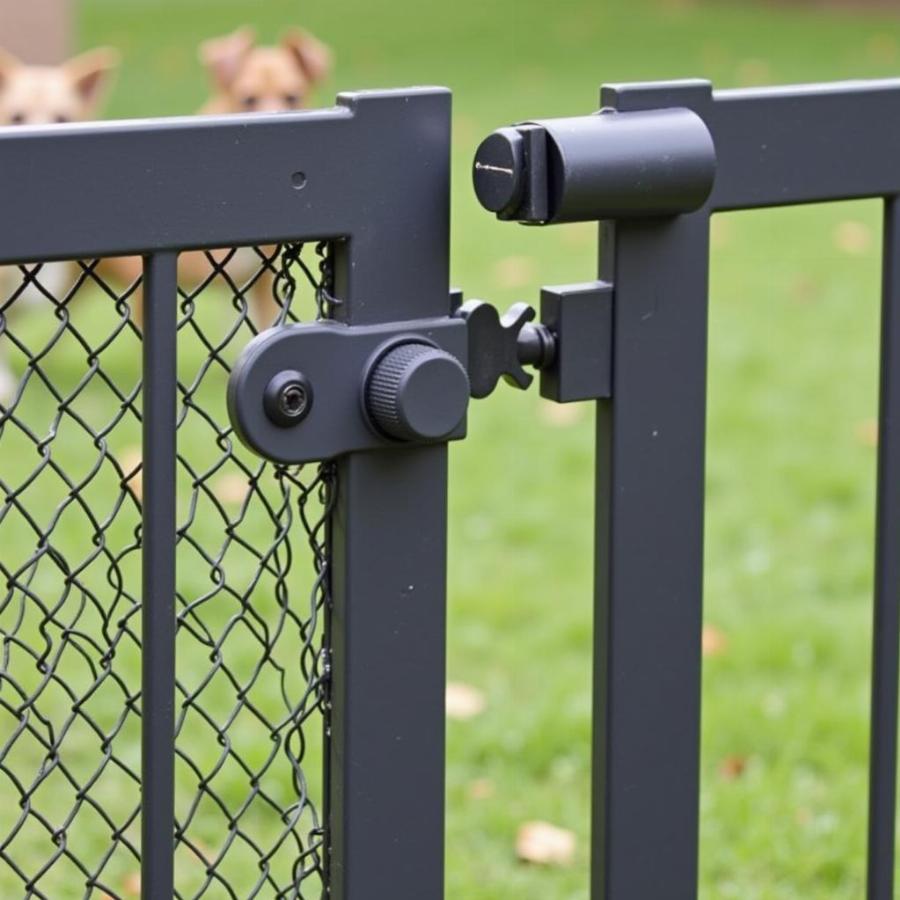Choosing the right outdoor gate for your dog is a crucial step in ensuring their safety and your peace of mind. An outdoor gate not only prevents your furry friend from wandering off and potentially getting lost or injured but also helps define boundaries and maintain a secure environment for your property. This article will guide you through the important factors to consider when selecting the perfect outdoor gate for your dog, offering expert tips and advice to help you make an informed decision.
Choosing the Right Height and Material for Your Outdoor Dog Gate
The height of your outdoor gate is paramount. Measure your dog from the ground to the top of their shoulders and add several inches to this measurement. This will deter even the most agile jumpers. Material is another key consideration. Durable materials like metal or strong, treated wood are ideal for withstanding the elements and your dog’s playful interactions. Avoid flimsy materials that can easily break or be chewed through.
What are the most common materials for outdoor dog gates? Metal and wood are the most popular, with metal offering superior strength and durability, while wood can blend more seamlessly with your garden aesthetics. Consider your dog’s chewing habits too. A determined chewer might make short work of a wooden gate, while metal presents a tougher challenge.
Different Types of Outdoor Gates for Dogs
There are several types of outdoor gates suitable for dogs, each designed with specific needs in mind. Freestanding gates are portable and easy to install, making them ideal for temporary use. Hardware-mounted gates offer a more permanent solution, providing added security. Walk-through gates, with their convenient latching mechanisms, allow easy access for humans while keeping your dog contained.
What about adjustable gates? These are excellent choices, especially if you have an unusual opening or need flexibility in the gate’s width. Pressure-mounted gates are suitable for doorways or narrower openings and are easy to install without any hardware.
Securing Your Outdoor Dog Gate
Ensuring your gate is securely latched is crucial for preventing escapes. Opt for latches that are dog-proof, meaning they are difficult for clever paws to manipulate. Regularly check the gate’s hinges and overall structure for any signs of wear and tear, addressing any issues promptly to maintain its integrity.
How can I make the latch even more secure? Consider adding a secondary locking mechanism, such as a padlock or carabiner, for added peace of mind, particularly if you have a particularly persistent escape artist. Also, make sure the ground around the gate is secure to prevent digging underneath.
 Secure Latch on Outdoor Dog Gate to Prevent Escapes
Secure Latch on Outdoor Dog Gate to Prevent Escapes
Integrating Your Dog’s Needs with Your Outdoor Gate
Consider your dog’s specific needs when choosing a gate. For smaller dogs, a lower gate might suffice, while larger breeds require taller and more robust barriers. Dogs with big paws, mentioned in this helpful article: dogs with big paws, may require a gate with tighter spacing between bars to prevent paw entrapment.
What if my dog is a jumper? Consider adding a top extension to your gate or choosing a design with an arched top, which can make it more challenging for them to scale. If you need dog stairs for a small dog in conjunction with your gate, check out this resource: dog stairs for small dogs.
Conclusion
Selecting the right outdoor gate for dogs is a vital aspect of responsible pet ownership. By carefully considering the height, material, type, and security features, you can create a safe and secure environment for your canine companion while enjoying the peace of mind that comes with knowing they are contained. Remember to choose a gate that meets your dog’s individual needs, ensuring their comfort and well-being.
FAQs
- What is the best material for an outdoor dog gate? Metal is typically the most durable and long-lasting.
- How tall should my outdoor dog gate be? Measure your dog’s height and add several inches.
- What are the different types of outdoor dog gates? Freestanding, hardware-mounted, pressure-mounted, and walk-through.
- How can I make my dog’s gate more secure? Use a dog-proof latch and consider a secondary locking mechanism.
- What should I consider for a dog that jumps? A taller gate, a top extension, or an arched top design.
- What if my dog has cold ears? While not directly related to gates, if your dog’s ears are cold, you can find helpful information here: dogs ears are cold.
- What can dogs eat when they have a cold? Find suitable food options in this article: what’s dogs cold eat.
Other Questions and Related Articles
- Are there specific gates for puppies?
- How can I train my dog to stay within the gate’s boundaries?
- Can I install an outdoor dog gate myself?
For information on dog-proof screen doors, see: screen door protector for dogs
Beaut Dogs is your ultimate resource for all things canine, providing reliable and in-depth information about the world of dogs. We offer expert guidance on breed characteristics, care tips, and much more. When you need assistance, please contact us at [email protected] for detailed and accurate answers from Beaut Dogs (Email address). Visit https://beautdogs.com today!